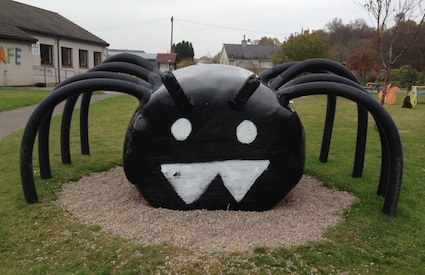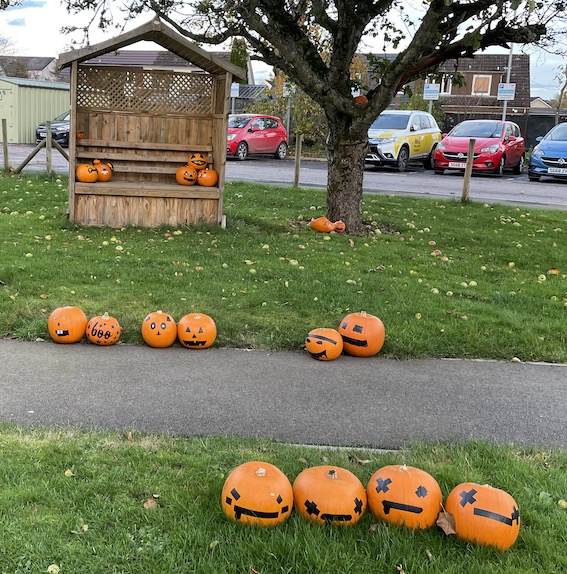
Halloween is a day where dressing up and having fun outside is celebrated. The origins of this festival are a matter of debate but this article is a useful starting point for any teacher wishing to acknowledge the cultural or religious connections. It is connected to the pagan festival which has the Gaelic name, Samhain and can also provide additional possibilities for learning about traditions.
My favourite Halloween took place many years ago whilst I was working in a tiny Highland school with 9 pupils on the roll. We booked the drama outreach worker from Eden Court Theatre for the day. All the children came to school dressed in their guising costumes. Together we worked on a collective guising performance. Prior to Halloween we had sent out letters to all the village residents to find out who would be willing to be visited and created a schedule. After dark we met at the agreed starting point and visited different homes providing a brief 5 minute micro-performance.
The local village community association had also organised a Halloween Party on the same night. After guising the children went to the village hall, only to see a dark building that was locked. On the door was a Halloween challenge that required the children to collect pieces of a broken key to put back together before being able to get into the hall. To locate the different parts, they were given clues which led them to different parts of the village. At the garage, the manager greeted them as a vampire in a coffin. At the railway station they met someone dressed as a mummy languishing in the shelter. Three witches greeted the children at the bus stop. Finally with the completed key, the children were able to access the village hall – lights came on and the party began. As well as snacks, the traditional games such as trying to eat apples hung on string and bobbing for apples took place. It was a really enjoyable night.
I hope you will find the rest of the suggestions in this post of interest and use…
1.Harvest your pumpkins and carve them to make a lantern as part of your outdoor decor. If you buy a pumpkin then save the seeds and plant them in Spring time. Alternatively, planning to grow neeps is good for the cool Scottish climates – fresh ones pulled out of the ground are easier to carve. There is confusion about pumpkins and leaving them outside. They are not okay for hedgehogs to eat. Instead, add them to your compost heap. Also have a look here for pumpkin recipes and other ideas for using pumpkins prior to composting.
2. Gather wind-fallen apples and create shrunken apple heads. Lily Rowe-Horseman has an excellent blog post which gives step-by-step instructions on her Kindling website. The results are scary!
3. Go on a spider hunt. If you see a spider on Halloween rumour has it is that it could be the death of a loved one watching you! If it is a misty morning, then look for spider webs. It is also a surprisingly hard challenge to make your own spider webs. Ask your children to consider how to do this… what equipment is needed? How does a spider begin this job? Where is a good place to site your spider web?
4. Decorate your garden or outdoor space with a Halloween theme. For a ghostly display fill up glass or plastic bottles with coloured water and shine a torch on them strapped to the outside but with the light facing inside the bottle. Below is a lovely display made for the geriatric and rehabilitation ward at my local hospital. It was created by a P6 class with pumpkins donated by a local supermarket.

5. Decorate leaves. Collect orange leaves. Use marker pens to create pumpkin like face carvings. To make ghost leaves, paint leaves with gloopy nylon-free clay. Let them dry. Add eyes with marker pens and leave in scary places to frighten people.
6. Walk the boundaries of your school grounds. Banish any unwanted spirits by making loud noises or banging on drums, etc.
7. Look for scary silhouettes and shadows made by natural or man made features. Better still, create your own shadows – look at Jane Hewitt’s blog post about how to do this.
8. Go on an orange and black colour hunt. With autumn in full flow, enjoying the range of orange colours and shades of black can raise children’s curiosity about why and how leaves die and the process of decomposition.
9. Hold an outdoor Halloween Party. Encourage your class or group to invent games for this, based upon known ideas. For example.
- An eyeball spoon race. Could you decorate a potato or egg in a scary way? What detail would you need to add?
- A ghost race. Could you blow air into a biodegradable plastic bag, tie a knot in it and bat it along with your hands or knees to stop it falling on the ground?
- A broomstick race. Find a long smooth stick. Time how long it takes to thread the broomstick through the legs of your team and out the other end.
- Dook for apples. Put an apple in a bowl of water and then try and retrieve it using only your mouth and teeth. An alternative is to put a length of string through the core, hang up the apple and then bite chunks out of it.
- Create a feely trail. Set up simple rope wound around trees or between objects. The children walk with their eyes closed or blindfolded, using the rope to guide them.At key points have items for children to feel. Remember to adapt this for the ages and abilities of your children to cope with uneven surfaces.
10. Enjoy learning more about cats, bats and owls. Ask a local wildlife expert to visit your class and boost children’s interests in animals. At one school we set up “Operation Catwatch” to learn more about how the local cat population used the school grounds and record cat activity. This can be helpful if people have concerns such as cats making a mess in sandpits as the frequency and nature of their visits can be monitored as part of a scientific study.
11. Create Stick Skeletons. This can be an absorbing activity especially if children are encouraged to feel their own bones inside them and look at pictures to get an accurate portrayal. Perhaps more materials are needed such as pebbles for the backbone. Likewise you can create a body outline and explore the different organs that are inside use. What natural materials could be used to accurately represent the different organs?
12. Create a pumpkin trail. Set up pumpkins at different places for children to locate. At each point have a short activity. This could be learning about the history traditions of Halloween, simple maths challenges, a literacy challenge or something even better! Get the children involved in making a trail for other classes to complete.
13. For family activities, the Family Adventure Project has lots of original ideas including ghost hunts, zombie walks, DIY horror movies and setting up a Halloween ambush.
Are you scared yet? You should be! If not, let me know of more fearsomely good seasonal activities.
This blog post is an update of one that I first wrote in October 2015.




















Love these ideas, when the boys are older I want to decorate the garden a bit more, but for now we’ll just have friendly pumpkins as my eldest is easily scared. I love the spider pic at the top, it’s fantastic! 🙂 x #countrykids
Thanks for commenting Jenny. Pumpkins are super and I agree about not scaring children! The spider was created by the workers at Easter Angus Farm.
Some lovely ideas here Juliet, I love the key in the lock story, how exciting that must have been. You would have adored the Halloween day we put on here on the farm yesterday from witch’s welly walks to Ghost train I’d love for you to have seen it all but I’ll share on Country Kids next week. Thank you for helping me with some ideas to add for next year.
Hi Fiona
I know you would be doing Halloween justice! I’ll look forward to next week 🙂
These are fantastic ideas. Added them to my favourites for next year.
Thank you! I appreciate they were published on the Coombe Mill blog a little late for use this year!